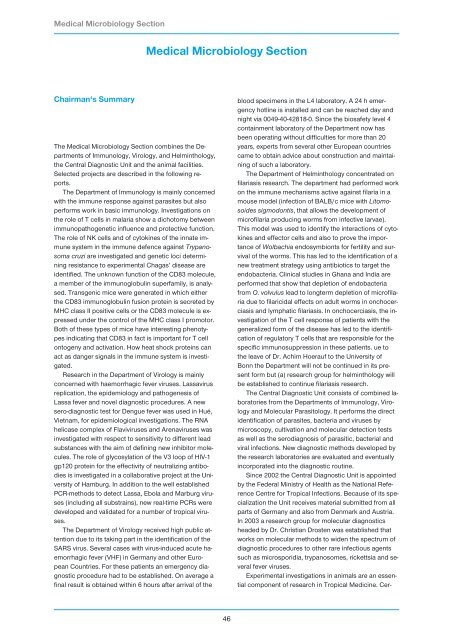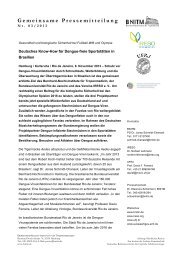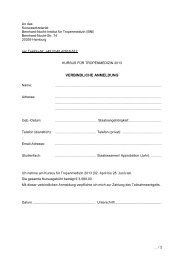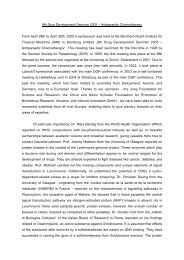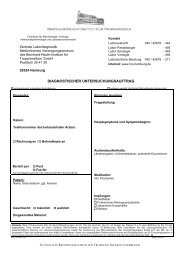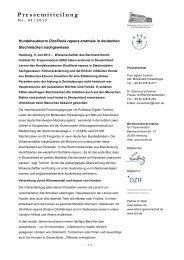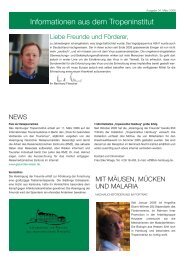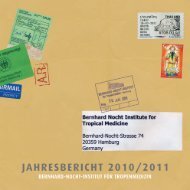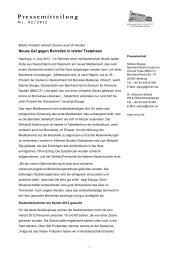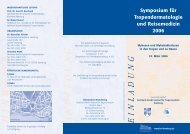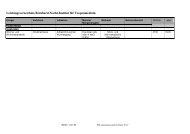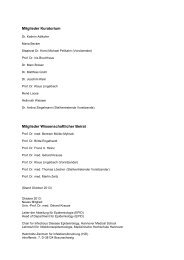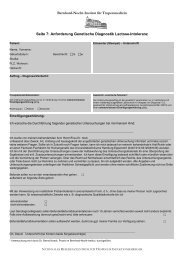Research Group Heussler (Malaria I) - Bernhard-Nocht-Institut für ...
Research Group Heussler (Malaria I) - Bernhard-Nocht-Institut für ...
Research Group Heussler (Malaria I) - Bernhard-Nocht-Institut für ...
Create successful ePaper yourself
Turn your PDF publications into a flip-book with our unique Google optimized e-Paper software.
Medical Microbiology Section<br />
Chairman‘s Summary<br />
The Medical Microbiology Section combines the Departments<br />
of Immunology, Virology, and Helminthology,<br />
the Central Diagnostic Unit and the animal facilities.<br />
Selected projects are described in the following reports.<br />
The Department of Immunology is mainly concerned<br />
with the immune response against parasites but also<br />
performs work in basic immunology. Investigations on<br />
the role of T cells in malaria show a dichotomy between<br />
immunopathogenetic influence and protective function.<br />
The role of NK cells and of cytokines of the innate immune<br />
system in the immune defence against Trypanosoma<br />
cruzi are investigated and genetic loci determining<br />
resistance to experimental Chagas’ disease are<br />
identified. The unknown function of the CD83 molecule,<br />
a member of the immunoglobulin superfamily, is analysed.<br />
Transgenic mice were generated in which either<br />
the CD83 immunoglobulin fusion protein is secreted by<br />
MHC class II positive cells or the CD83 molecule is expressed<br />
under the control of the MHC class I promotor.<br />
Both of these types of mice have interesting phenotypes<br />
indicating that CD83 in fact is important for T cell<br />
ontogeny and activation. How heat shock proteins can<br />
act as danger signals in the immune system is investigated.<br />
<strong>Research</strong> in the Department of Virology is mainly<br />
concerned with haemorrhagic fever viruses. Lassavirus<br />
replication, the epidemiology and pathogenesis of<br />
Lassa fever and novel diagnostic procedures. A new<br />
sero-diagnostic test for Dengue fever was used in Hué,<br />
Vietnam, for epidemiological investigations. The RNA<br />
helicase complex of Flaviviruses and Arenaviruses was<br />
investigated with respect to sensitivity to different lead<br />
substances with the aim of defining new inhibitor molecules.<br />
The role of glycosylation of the V3 loop of HIV-1<br />
gp120 protein for the effectivity of neutralizing antibodies<br />
is investigated in a collaborative project at the University<br />
of Hamburg. In addition to the well established<br />
PCR-methods to detect Lassa, Ebola and Marburg viruses<br />
(including all substrains), new real-time PCRs were<br />
developed and validated for a number of tropical viruses.<br />
The Department of Virology received high public attention<br />
due to its taking part in the identification of the<br />
SARS virus. Several cases with virus-induced acute haemorrhagic<br />
fever (VHF) in Germany and other European<br />
Countries. For these patients an emergency diagnostic<br />
procedure had to be established. On average a<br />
final result is obtained within 6 hours after arrival of the<br />
Medical Microbiology Section<br />
46<br />
blood specimens in the L4 laboratory. A 24 h emergency<br />
hotline is installed and can be reached day and<br />
night via 0049-40-42818-0. Since the biosafety level 4<br />
containment laboratory of the Department now has<br />
been operating without difficulties for more than 20<br />
years, experts from several other European countries<br />
came to obtain advice about construction and maintaining<br />
of such a laboratory.<br />
The Department of Helminthology concentrated on<br />
filariasis research. The department had performed work<br />
on the immune mechanisms active against filaria in a<br />
mouse model (infection of BALB/c mice with Litomosoides<br />
sigmodontis, that allows the development of<br />
microfilaria producing worms from infective larvae).<br />
This model was used to identify the interactions of cytokines<br />
and effector cells and also to prove the importance<br />
of Wolbachia endosymbionts for fertility and survival<br />
of the worms. This has led to the identification of a<br />
new treatment strategy using antibiotics to target the<br />
endobacteria. Clinical studies in Ghana and India are<br />
performed that show that depletion of endobacteria<br />
from O. volvulus lead to longterm depletion of microfilaria<br />
due to filaricidal effects on adult worms in onchocerciasis<br />
and lymphatic filariasis. In onchocerciasis, the investigation<br />
of the T cell response of patients with the<br />
generalized form of the disease has led to the identification<br />
of regulatory T cells that are responsible for the<br />
specific immunosuppression in these patients. ue to<br />
the leave of Dr. Achim Hoerauf to the University of<br />
Bonn the Department will not be continued in its present<br />
form but (a) research group for helminthology will<br />
be established to continue filariasis research.<br />
The Central Diagnostic Unit consists of combined laboratories<br />
from the Departments of Immunology, Virology<br />
and Molecular Parasitology. It performs the direct<br />
identification of parasites, bacteria and viruses by<br />
microscopy, cultivation and molecular detection tests<br />
as well as the serodiagnosis of parasitic, bacterial and<br />
viral infections. New diagnostic methods developed by<br />
the research laboratories are evaluated and eventually<br />
incorporated into the diagnostic routine.<br />
Since 2002 the Central Diagnostic Unit is appointed<br />
by the Federal Ministry of Health as the National Reference<br />
Centre for Tropical Infections. Because of its specialization<br />
the Unit receives material submitted from all<br />
parts of Germany and also from Denmark and Austria.<br />
In 2003 a research group for molecular diagnostics<br />
headed by Dr. Christian Drosten was established that<br />
works on molecular methods to widen the spectrum of<br />
diagnostic procedures to other rare infectious agents<br />
such as microsporidia, trypanosomes, rickettsia and several<br />
fever viruses.<br />
Experimental investigations in animals are an essential<br />
component of research in Tropical Medicine. Cer-


